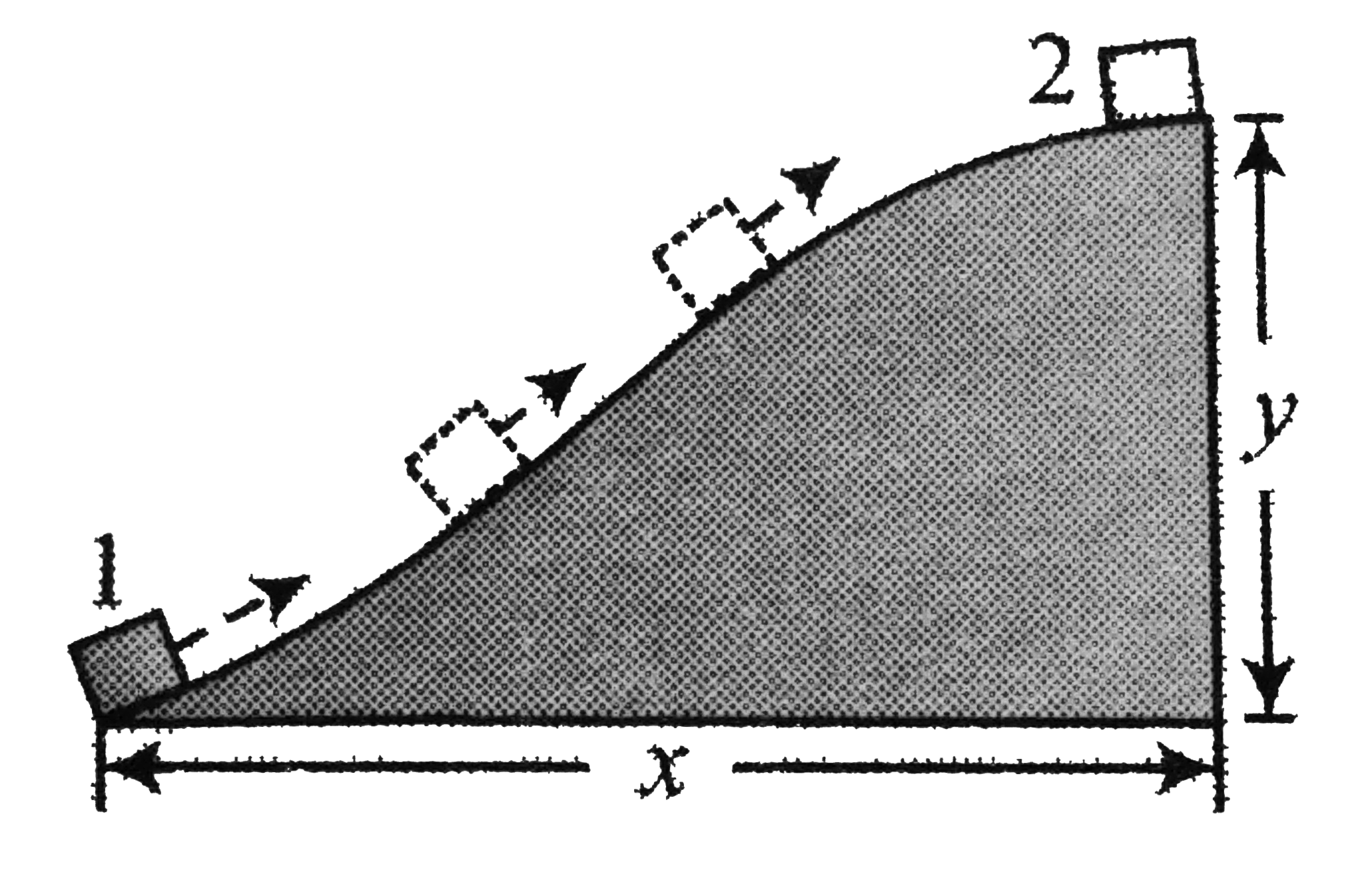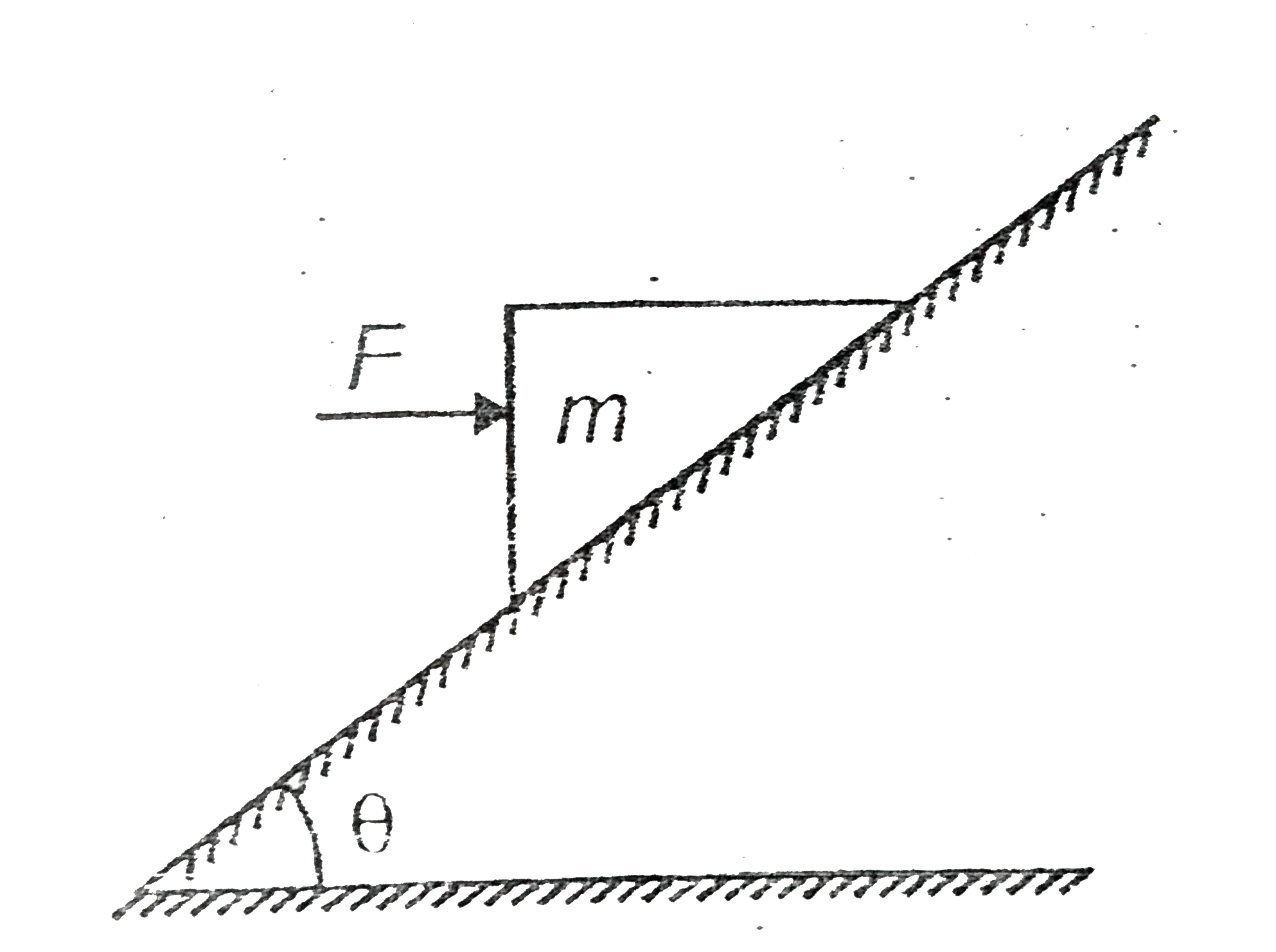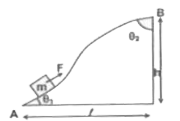A block of mass m is slowly pulled along a curved surface from position 1 and 2. If the coefficient of kinetic friction between the block and surface is μ, find the work done by the applied force.

The forces acting on the block are gravity,
mg↓, N↑, fk↓, and F↑.
Using W-E theorem: W=ΔK

WN+Wgr+WN=Wf=ΔK (i)
For slowly shifting the body,
ΔK=0 (ii)
Work done normal reaction
WN=→N⋅d→s=0 (∴N⊥ds) (iii)
Work done by the gravity
Wgr=−mgy ( ∴ the block moves up) (iv)
Using equations(i), (ii), (iii), and (iv),
WF+Wf=mgy (v)
Wf=∫→fk⋅→ds
=∫fkdscos180∘
=−∫fkds=−∫μNds
=−∫μ(mgcosθ)ds
=−μmg∫dscosθ(dscosθ)=dx)
=−μmg∫x0dx=−μmgx (vi)
Using equations (v) and (vi), WF=mg(μx+y)
Topper's Solved these Questions
- WORK, POWER & ENERGYBOOK - CENGAGE PHYSICS ENGLISHCHAPTER - WORK, POWER & ENERGYEXERCISE - Exercise 8.1
25 Videos
- WORK, POWER & ENERGYBOOK - CENGAGE PHYSICS ENGLISHCHAPTER - WORK, POWER & ENERGYEXERCISE - Exercise 8.2
25 Videos
- WORK, POWER & ENERGYBOOK - CENGAGE PHYSICS ENGLISHCHAPTER - WORK, POWER & ENERGYEXERCISE - Archives (integer)
4 Videos
- VECTORSBOOK - CENGAGE PHYSICS ENGLISHCHAPTER - VECTORSEXERCISE - Exercise Multiple Correct
5 Videos
Similar Questions
A prismatic block of mass m is lifted through a distanced along the slant. If the coefficient of friction between the block and slant surface is 1μ. find the
(A) Work done by force F, friction and gravity.
(B) Speed of the block after moving through a distance d.
Assuming,μ=1/6,θ=45%∘andF=2mg

View SolutionA horizontal constant force F pulls a block of mass m placed on a horizontal surface. If the coefficient of kinetic friction between the block and ground is μ, find the power delivered by the external agent after a time agent after a time t measured from the beginning of action of the force.
View Solution
Knowledge Check
A block of mass 1 kg lies on a horizontal surface in a truck. The coefficient of static friction between the block and the surface is 0.6. If the acceleration of the truck is 5m/s2, the frictional force acting on the block is…………newtons.
A10NB5NC2.5ND20N
A block of mass m is moving on a rough horizontal surface. μ is the coefficient of kinetic friction between the block and the surface. What is the net force exerted by the surface on the block?
View SolutionA block of mass M is kept on as rough horizontal surface. The coefficient of static friction between the block and the surface is μ. The block is to be pulled by applying a force to it. What minimum force is needed to slide the block? In which direction should this force act?
View SolutionA spring, placed horizontally on a rough surface is compressed by a block of mass m, placed on the same surface so as to store maximum energy in the spring. If the coefficient of friction between the block and the surface is μ, the potential energy stored in the spring is
View SolutionA block of mass M is kept on as rough horizontal surface. The coefficient of static frictionbetween the block and the surface is μ. The block is to be pulled by applying a force to it. What minimum force is needed to slide the block? In which direction should this force act?
View SolutionA block of mass 1 kg lies on a horizontal surface in a truck. The coefficient of static friction between the block and the surface is 0.6. If the acceleration of the truck is 5m/s2, the frictional force acting on the block is…………newtons.
View SolutionA block of mass m is slowly carried on a inclined plane by a force F which always acts along the tangent to the plane. If the co-efficient of friction between the block and incline be μ, then work done by force of friction while carrying block from bottom of the plane to the top will be :

A. dependent on the actual shape of the path between point A and B.
B. will have a total positive value
C. will not change if force F is not applied along the tangent to the plane always.
D. independent of the actual shape of the path between points A and B.
View SolutionA block of mass m is placed at rest on an inclination θ to the horizontal. If the coefficient of friction between the block and the plane is μ, then the total force the inclined plane exerts on the block is
View Solution
